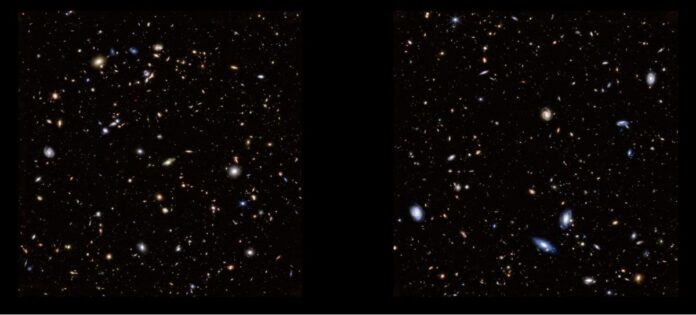NASA’s James Webb Space Telescope (JWST) has turned its sharp eyes on a distant patch of sky made famous by its predecessor.
A newly released JWST photo captures the Hubble Ultra Deep Field (HUDF), a faraway region in the southern constellation Fornax (the Furnace). The HUDF has long been “an extremely fertile hunting ground (opens in new tab)” for astronomers, as it contains at least 10,000 galaxies dating back to just 800 million years after the Big Bang, providing a glimpse into how the very first galaxies may have formed.
When NASA’s Hubble Space Telescope observed this pocket of the universe in late 2003, it clicked the first images of galaxies at the farthest distances ever known. At the time, Hubble’s representatives said this record is “unlikely to be surpassed (opens in new tab)” until Webb comes onto the stage.
Related: James Webb Space Telescope: Everything you need to know
Two decades later, Webb observed the same region at similar depths that Hubble did — which means Webb could see galaxies as faint as its precursor — “in just one-tenth as much observing time,” NASA representatives wrote in an image description (opens in new tab) published on Wednesday (April 13).
While Hubble took 11.3 days to click the image, Webb one-upped the record in just a little over 20 hours. The latest image is also unveiling young galaxies that were not seen previously, astronomers said.
“The fact that we see hot, ionized gas is telling us exactly where stars are being born in these galaxies,” Michael Maseda, an astronomy professor at the University of Wisconsin-Madison, said in a statement (opens in new tab). “Now we can separate those areas from where stars already existed. That piece of information is very important because, billions of years later, we don’t exactly know how galaxies became how they are today.”
The image, which was snapped in infrared wavelengths by JWST’s powerful Near-Infrared Camera (NIRCam) instrument, is helping astronomers piece together the universe’s history in the first billion years after the Big Bang. This period, which is when the first cohort of stars were born, is called the reionization era.
Galaxies this early on were not as well defined as the ones we see closer to our Milky Way, which itself is a fine-tuned spiral galaxy. In this early slice of the universe, astronomers have previously spotted one galaxy shaped like a toothpick and another like a bracelet link. What will Webb’s image end up revealing?
Follow Sharmila Kuthunur on Twitter @Sharmilakg (opens in new tab). Follow us on Twitter @Spacedotcom (opens in new tab) and on Facebook (opens in new tab).

